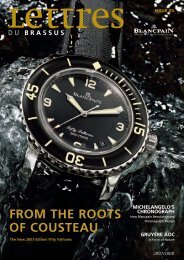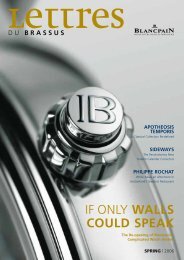THE HISTORY OF BLANCPAIN
THE HISTORY OF BLANCPAIN
THE HISTORY OF BLANCPAIN
You also want an ePaper? Increase the reach of your titles
YUMPU automatically turns print PDFs into web optimized ePapers that Google loves.
equired before Blancpain in 2003 could<br />
introduce the world’s first wristwatch with a<br />
sapphire bezel with luminova markings in the<br />
50th Anniversary Edition of the Fifty Fathoms.<br />
Blancpain did not imagine the project simply<br />
as one to adapt a scratch resistant material<br />
for the Fifty Fathoms bezel. Instead the task<br />
was far more demanding. It wanted to capture<br />
all of the allure and design of the iconic<br />
Fifty Fathoms which first debuted in 1953,<br />
but realised with modern and innovative<br />
materials. Thus it would not be enough to<br />
simply place a sapphire ring on the bezel and<br />
declare the job done. The resulting bezel had<br />
to capture the vintage look and feel of its<br />
original ancestor which had a black colour<br />
and luminous marking, both of which were<br />
critical legibility elements for diving. Similarly<br />
the crystal itself was made part of the project.<br />
Unlike bezels, sapphire crystals were not only<br />
common in the industry, they had become<br />
the norm. But the crystal for the Anniversary<br />
Fifty Fathoms had to achieve the look of the<br />
original 1953 piece, which was not flat but<br />
bombée, originally done to enhance its ability<br />
to resist water pressure during deep dives. So<br />
the bezel project and crystal project became<br />
joined as Blancpain undertook to recreate the<br />
spirit of the past with modern sapphire technology.<br />
There were multiple challenges which had<br />
to be confronted to make the world’s first<br />
sapphire bezel with super luminova a reality.<br />
First was developing a process to imbue the<br />
bezel with colour and provide for the luminova<br />
markings. The ingenious solution was<br />
to apply layers of lacquer to the flat bottom<br />
side of the sapphire bezel ring and therefollowing<br />
to carve out all of the areas for the<br />
markings. Once sculpted out from the laquer<br />
layers, super luminova could be applied, producing<br />
luminous markings which would be<br />
visible from the top surface.<br />
With both laquer colour now applied and<br />
luminous markings achieved, we are still far<br />
from a finished bezel. Extensive work fol-<br />
30<br />
| 31<br />
lowed to find a sealing material to protect<br />
the bottom surface but not harm or alter<br />
the colour of the laquer or markings.<br />
Months of trial and error and testing were<br />
devoted to finding the right sealant.<br />
Attention then shifted to the shape of<br />
the sapphire ring. A flat top surface was<br />
the norm for other diving watches in the<br />
industry. Those that were formed with<br />
some degree of curvature bore markings<br />
that were essentially on the curved surface.<br />
In both of these instances there was<br />
little visual interest in the bezel beyond the<br />
colour and markings themselves. But with<br />
the markings on the bottom surface of the<br />
sapphire ring, Blancpain had the opportunity<br />
to endow the bezel with a visual<br />
depth never before achieved. The sapphire<br />
ring was seen as a form of lens which,<br />
with the proper degree of top surface<br />
rounding, could bring both life and a<br />
minor degree of magnification to the<br />
markings underneath.







